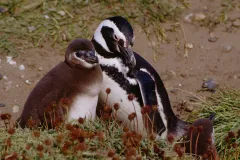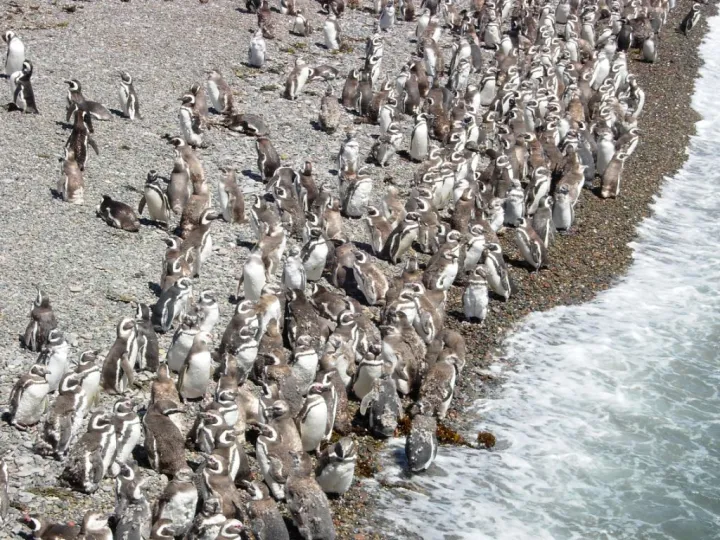Penguin Health Equals Ocean Health

It’s hard not to identify with penguins as they waddle about upright on land, clad in their tuxedo-like plumage. In their crowded breeding colonies, they squabble with and show off to their neighbors, sometimes resorting to petty theft. One can almost imagine joining the end of the queue when they follow one another in single file along icy paths, sometimes slipping or body sledding along the way.
Penguins do far more than make us smile, however; they also play important roles in ecosystems both in the ocean and on land. Penguins—adults, young and eggs—serve as food for predators such as leopard seals and seabirds in cold areas, along with foxes, leopards, and even crabs in warmer climates. By chasing after fish, squid and krill, they affect prey populations wherever they hunt. They carry nutrients between land and sea, and enrich both with their feces. Some burrowing species even modify the landscape as they dig nests into the ground.
But many species of penguins are declining in numbers and, because they feed in the ocean and breed on land, they face threats in both realms. Of the 18 species of penguins alive today, 11 are listed as threatened with extinction by the IUCN (International Union for the Conservation of Nature). In the last 25 years, 14 species have been upgraded to a more severe conservation status because of human-induced changes to their ecosystems. Climate change, pollution, and overfishing impoverish penguins’ ocean habitat, while habitat degradation, introduced predators and human disturbance are affecting penguins on land.

Penguins have features that make them particularly sensitive to human activities. They are flightless, making it difficult for them to escape from introduced predators like housecats and rats, and their Southern Hemisphere homes are warming rapidly. They depend on marine food sources that can be unpredictable, putting them at risk for starvation. Penguins are also long-lived, only laying one or two eggs each year, and take several months to raise their offspring. This slow growth restricts their ability to recover quickly from both natural and human-caused disasters. In addition, penguins make use of very wide geographical areas in the ocean when they forage and, during winter migrations, are exposed to a variety of threats like oil pollution and lack of fish for food. This means that penguin populations can reflect the health of the oceans, acting as sentinels and providing important information about changing ecosystems.
For example, Punta Tombo, Argentina is the home of the largest Magellanic penguin colony on the planet, with 400,000 breeding penguins. Although the numbers of penguins increased rapidly between the 1920s (when the colony first formed) and the 1970s, the numbers have declined by 24 percent in the last two decades. This is serious in its own right, and even more so because penguins often move from this colony to others in the region, keeping those colonies growing and healthy. The Punta Tombo colony also supports an eco-tourism site that is important for the regional economy.
The colony seems to be declining for several reasons, but food scarcity is almost certainly playing a role. While they can swim quite far—these medium sized penguins migrate between the southern coast of South America and central Brazil—they don’t travel such a long distance when foraging for food. The average foraging distance varies with how much energy the penguins are putting into taking care of an egg or chick. Until recently, the average trek from the colony was 411 km (255 miles) during egg incubation, 61 km (38 miles) during early chick stage, and 111 km (69 miles) for older chicks. But from 1997 to 2007, the average distance a penguin traveled to forage during each of these phases increased 80 km for each trip, likely due to a lack of food availability close to the colony. Spending more time hunting for the same amount of food means less food for chicks, reducing the number of chicks that make it to adulthood. The lack of food can be linked directly to overfishing, but also is connected to their traditional food supply moving elsewhere in the face of warming oceans.
The Global Penguin Society (GPS) is an international science-based conservation coalition created to foster the protection of the world’s penguin species. Currently GPS is working with the Argentinian government and key community stakeholders to designate 400,000 hectares (1,500 square miles) of protected ocean for Magellanic penguins at Punta Tombo. (The current protected area of the Provincial reserve at Punta Tombo is only 210 hectares (less than one square mile) and includes only about half of the breeding colony.) There are also plans to enlarge the current protection on land and to include another nearby penguin colony of 100,000 breeders, with the hope of designating the area as a UNESCO Biosphere Reserve.
We tend to think of marine protected areas as a tool for protecting fish populations, but fish are the not only creatures to suffer from overfishing. Because penguins spend 75 percent of their lives in the ocean and depend on healthy fish stocks, MPAs are vital for their future as well, reducing at least some of the threats that they face in a changing world.


